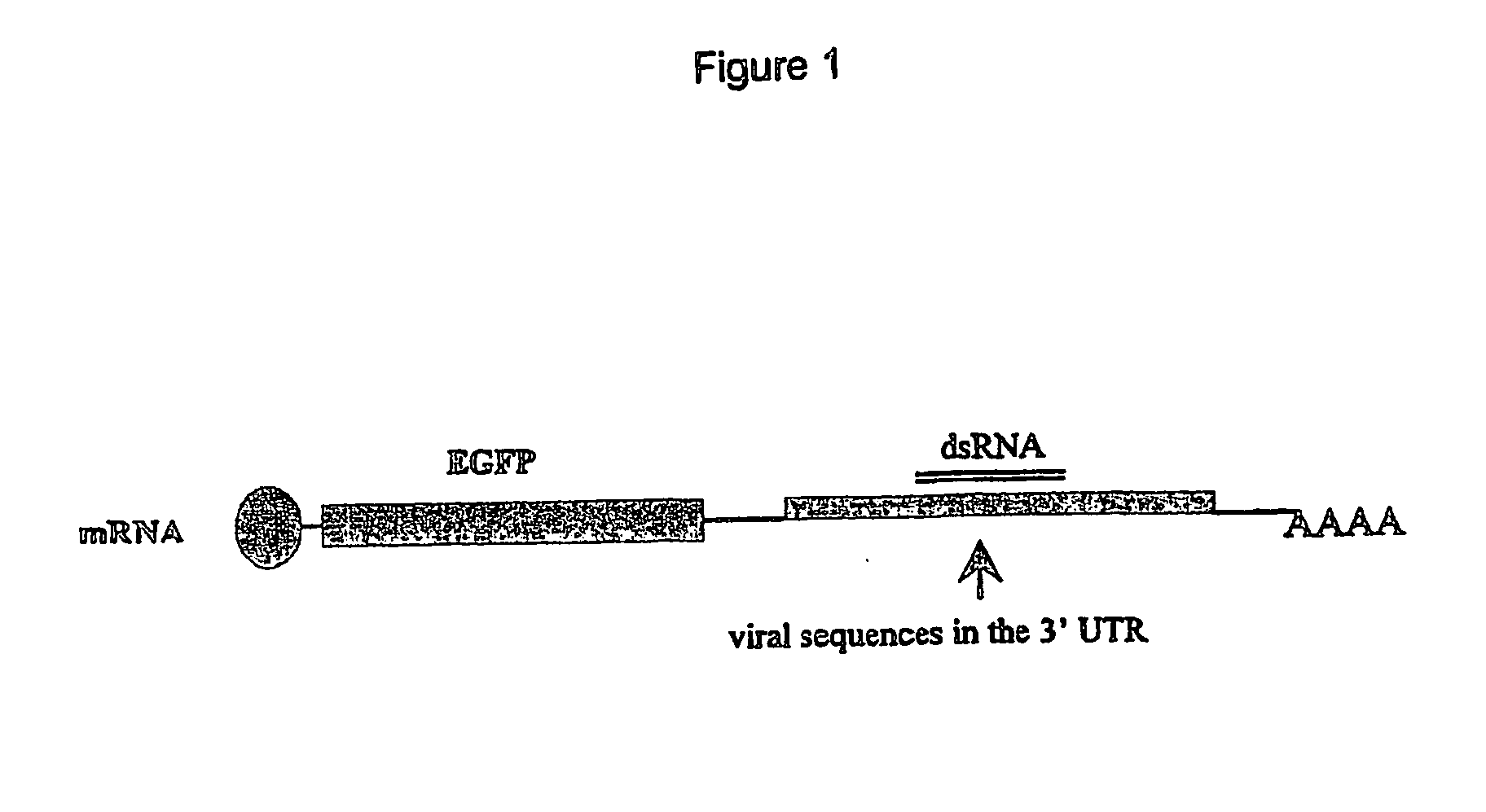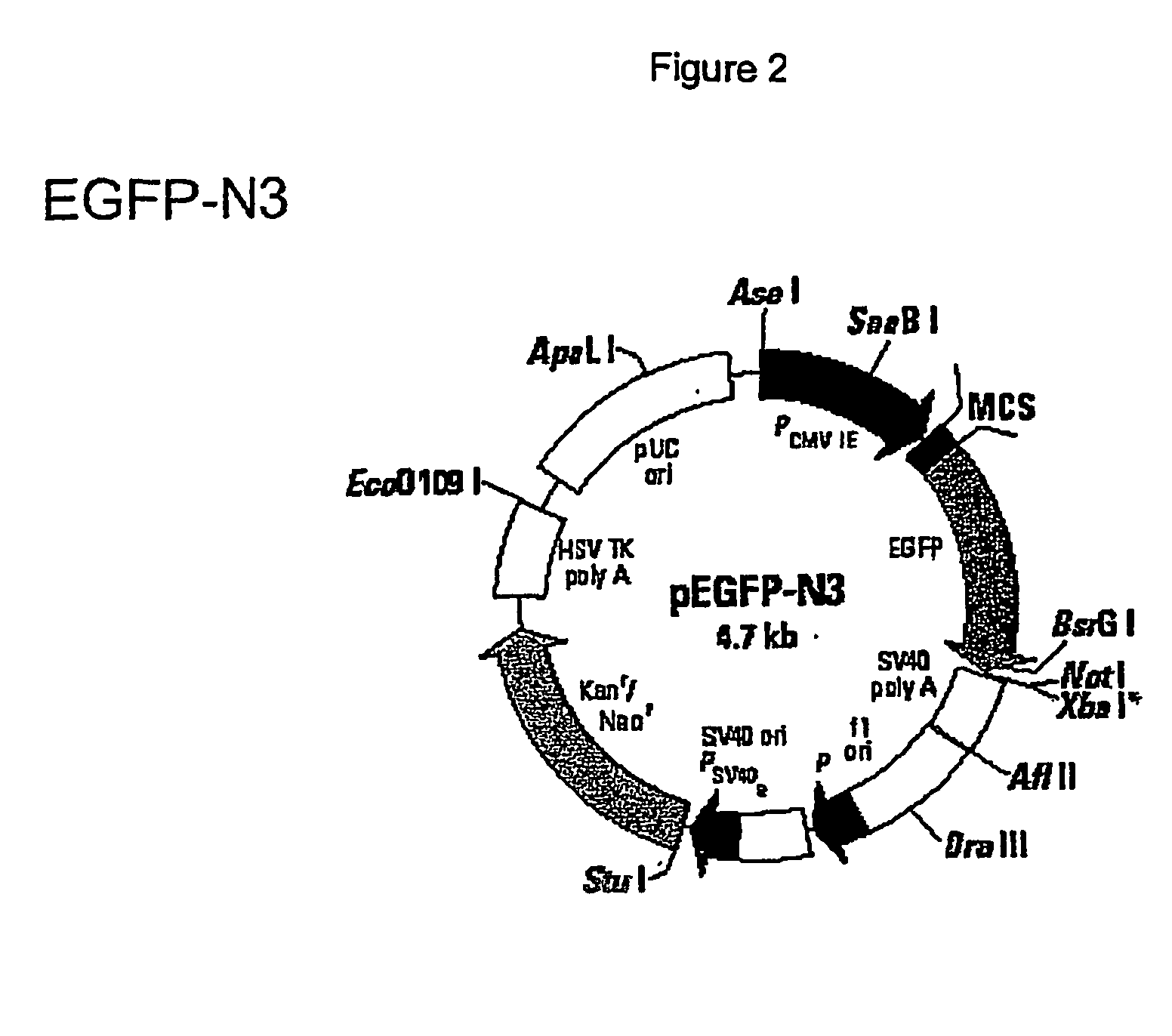Methods and constructs for evaluation of rnai targets and effector molecules
a technology of effector molecules and methods, applied in the field of posttranscriptional gene silencing or rna interference, can solve the problem of no rules for selecting optimal targets and effectors, and achieve the effect of evaluating the relative effectiveness of selected effector molecules
- Summary
- Abstract
- Description
- Claims
- Application Information
AI Technical Summary
Benefits of technology
Problems solved by technology
Method used
Image
Examples
example 1
Construction of an mRNA Fusion Vector
[0027] Vector preparation: pEGFP-N3 (FIG. 2) a commercially available vector obtained from Clontech [(BD Biosciences Clontech, 1020 East Meadow Circle, Palo Alto, Calif. 94303) GenBank Accession #: U57609, Clontech Catalog #6080-1, See Catalog PR 08395, published 30 Aug. 2000, which provides a restriction map and detailed information about the vector, including the following: pEGFP-N3 encodes a red-shifted variant of wild-type GFP, which has been optimized for brighter fluorescence and higher expression in mammalian cells. pEGFP-N3 encodes the GFPmut1 variant which contains the double amino acid substitution of Phe-64 to Leu and Ser-65 to Thr. The coding sequence of the EGFP gene contains more than 190 silent base changes which correspond to human codon-usage preferences. Sequences flanking EGFP have been converted to Kozak consensus translation initiation site to further increase the translation efficiency in eukaryotic cells.
[0028] EGFP-N3 v...
example 1a
Human RD Cells, Transfections and Summary of Results
[0031] Human RD cells (Rhabdomyosarcoma / Human Embryonal Rhabdomyososarcoma) (available from ATCC, as well as other sources) were co-transfected with:
A) EGFP / HBVsAg (Enhanced green fluorescent protein / Hepatitis B virus surface Ag) fusion mRNA construct and an siRNA derived from HBV (siRNA#1)[note that siRNA#1 maps to a subset of the HBV derived sequences cloned into the 3′UTR of EGFP / HBVsAg];
[0032] B) EGFP / HBVsAg fusion mRNA construct and a control siRNA (siRNA#2); or C) EGFP-N3 (EGFP plasmid without HBVsAg sequences) and siRNA#1. EGFP expression was monitored by fluorescent microscopy for 7 days. EGFP expression was down-regulated from 2-7 days post-transfection only in those cells co-transfected with the EGFP / HBVsAg fusion mRNA construct and siRNA#1. Levels of fluorescence were not down-regulated in cells transfected with EGFP-N3 plus siRNA#1, EGFP / HBVsAg fusion mRNA construct plus siRNA#2, EGFP-N3 plasmid alone (data not sho...
example 1b
[0036] To demonstrate that siRNA#1 can also target HBV sequences in a more native conformation, i.e., in the absence of EGFP mRNA sequences, the following experiment was done. An HBVsAg expression vector was constructed. This vector contains HBVsAg sequences derived from the HBV target sequence contained in the EGFP / HBVsAg fusion vector including those sequences corresponding to siRNA#1. The construct is designed to express middle sAg. Expression is directed by the HCMV promoter and the SV40 polyadenylation signal. Construction of such a vector can be easily accomplished by one skilled in the art.
In this experiment, RD cells were transfected with:
A) the HBVsAGg expression vector and siRNA#1;
B) the HBVsAg expression vector and siRNA#2; and
C) the HBVsAg expression vector alone.
[0037] All transfections were performed as described for the fusion mRNA vector transfections using Lipofectamine. Transfection A contained 300 ng HBVsAg expression vector, 2 ug siRNA#1 and 2 ug pGL3-ba...
PUM
| Property | Measurement | Unit |
|---|---|---|
| Fluorescence | aaaaa | aaaaa |
| Chemiluminescence | aaaaa | aaaaa |
Abstract
Description
Claims
Application Information
 Login to View More
Login to View More - R&D
- Intellectual Property
- Life Sciences
- Materials
- Tech Scout
- Unparalleled Data Quality
- Higher Quality Content
- 60% Fewer Hallucinations
Browse by: Latest US Patents, China's latest patents, Technical Efficacy Thesaurus, Application Domain, Technology Topic, Popular Technical Reports.
© 2025 PatSnap. All rights reserved.Legal|Privacy policy|Modern Slavery Act Transparency Statement|Sitemap|About US| Contact US: help@patsnap.com



